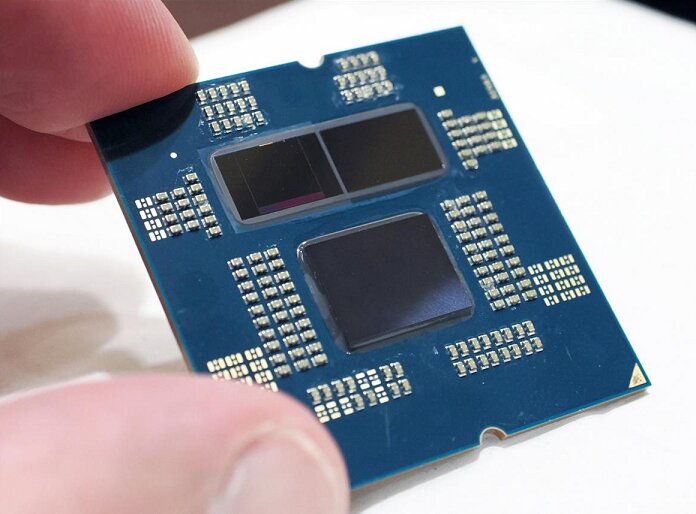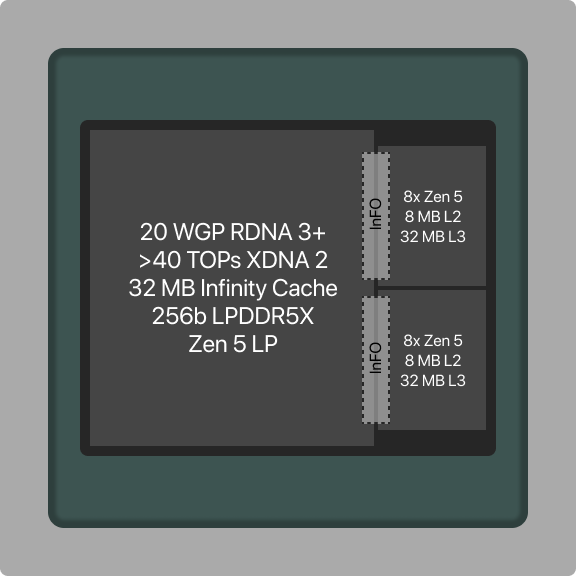- AMD’s next-generation mobile APUs seem too good to be true.
- AMD Strix Point CPUs are an incremental upgrade over the current mobile lineup.
- The Strix Halo APUs have monstrous iGPUs and can compete with dedicated GPUs.
Although AMD has been releasing laptop CPUs for quite a while now, they have not been able to claw back much of Intel’s market share in this category. AMD’s laptop CPUs have been adequate in terms of performance, but they do lack in certain aspects, such as efficiency, scalability, and integrated graphics.
Fortunately, that all seems to be changing in the near future.
AMD Strix Point and Strix Halo
AMD has been using two designs for its desktop and laptop CPUs, namely Dragon Range and Phoenix Point. These two represent distinctly different design approaches for processors, as the former is a chiplet-based design while the latter uses a monolithic die.
With the upcoming AMD Strix design, it looks like AMD is introducing another mobile series that will bridge the gap between its desktop and laptop parts for the Zen 5 generation. Strix Point is rumoured to be a monolithic design for next-gen laptops, while AMD Strix Halo is a chipset-based APU design for high-end laptops and integrated machines.

Out of the two, the Strix Point CPUs are a little more straightforward and can be thought of as an incremental upgrade over current Ryzen laptop CPUs. However, the Strix Halo series is where things really get interesting.
AMD Strix Halo APUs – What Are They?
According to leaks, the AMD Strix Halo APUs represent the pinnacle of the next generation of AMD’s mobile offerings, and AMD seems to have doubled down on the graphics side of things for this series. The rumored flagship processor is thought to be a chiplet-based design with 16 Zen 5 cores as well as 32 threads, which is already a very healthy configuration. However, the fun only begins here.
Allegedly, AMD has only gone and slapped a 40 CU RDNA 3.5 GPU onto the CPU die, which also includes 32MB of Infinity Cache. This is a massive GPU for an integrated design and would hypothetically be twice as powerful as a Radeon RX 6750 XT, which is already a pretty respectable mid-range GPU. Estimates suggest the theoretical performance of a GeForce RTX 4060 in gaming applications as well.

Moreover, this would be the first time that we see an Infinity Cache on an iGPU. AMD is allegedly using an LPDDR5X bus, which is 256-bit wide and is quite enormous for an integrated GPU. Feeding such a powerful GPU is a demanding task, which is why AMD is expected to use blazing-fast 8.5 GT/s LPDDR5X memory for this setup.
What Can We Expect?
AMD’s shifting focus to high-end integrated APUs reflects a growing trend in the industry. We have already seen the impact of Apple’s M Silicon, which is another example of an integrated CPU that maximizes efficiency. AMD’s approach is different, but there are certain similarities as well, which point towards that trend.

It is quite surprising to see such a concentrated effort being put into APUs from a company that did not offer iGPUs on any of its Ryzen desktop CPUs until about a year ago, but that’s beside the point. One look at the integrated hardware of the PlayStation 5 or Xbox Series consoles, and you will realize how impressive AMD’s custom solutions can be.
The Strix Halo APUs are not just incremental upgrades over the previous AMD Ryzen laptop processors, they are set to change the game entirely. The leaks suggest that this design will be scalable all the way down to a 6-core processor mated to a 20CU GPU, which is more than enough graphics power for mid-range gaming as of the time of writing.

This means that, in the face of declining gaming revenue, AMD has found a new pathway that can help it gain some traction in that market category again.
More Questions Than Answers – For Now
With an APU as powerful as the one being rumored, can you eliminate the need for a dedicated GPU altogether? How good will this integrated GPU be in productivity tasks? What will the thermal demands be like?
Of course, these are all questions that are yet to be answered. The logical next step for AMD is to develop a desktop APU using this platform that can blow the doors off of most budget GPUs on the market today. But can the current technology do that? And even if it can, will AMD willingly want to compete with its own Radeon division? We shall see.
One thing is for certain. Apple has set a snowball rolling with its M Silicon, and the PC industry needs to catch up quickly.
Thank you! Please share your positive feedback. 🔋
How could we improve this post? Please Help us. 😔
[Reviews Specialist]
Usman Saleem brings 8+ years of comprehensive PC hardware expertise to the table. His journey in the tech world has involved in-depth tech analysis and insightful PC hardware reviews, perfecting over 6+ years of dedicated work. Usman’s commitment to staying authentic and relevant in the field is underscored by many professional certifications, including a recent one in Google IT Support Specialization.
8+ years of specialized PC hardware coverage
6+ years of in-depth PC hardware analysis and reviews
Lead PC hardware expert across multiple tech journalism platforms
Certified in Google IT Support Specialization
Get In Touch: usman@tech4gamers.com


 Threads
Threads

